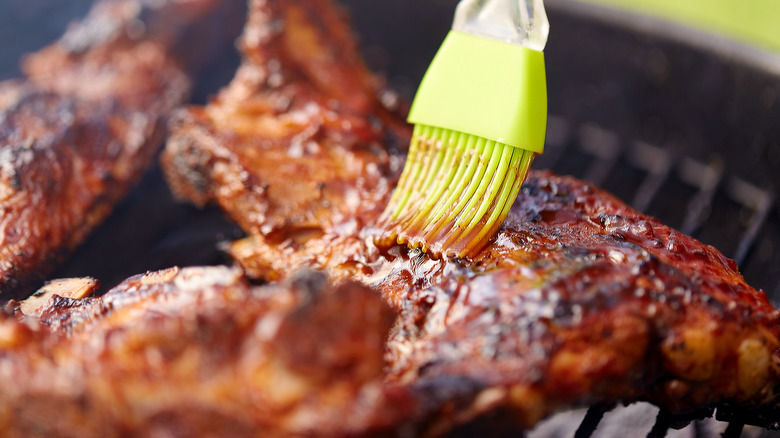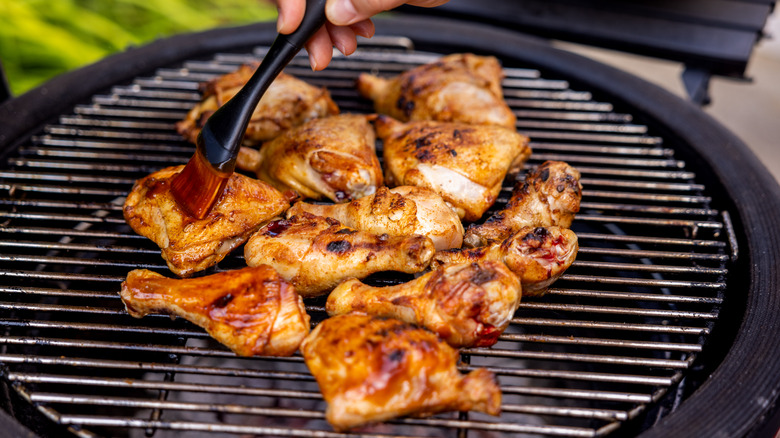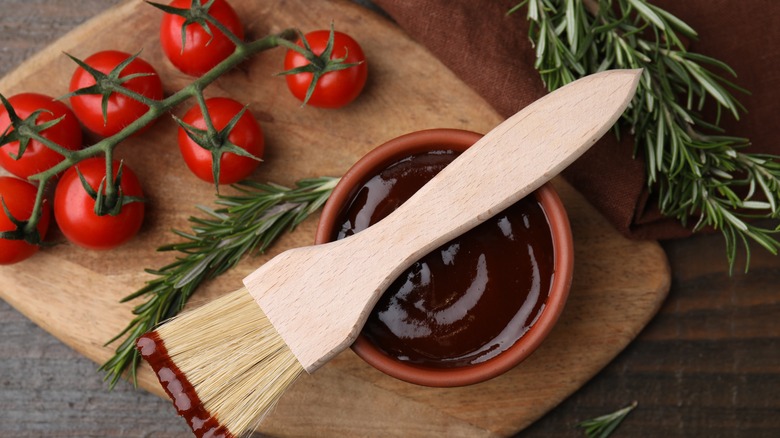For Way Tastier Grilled Meat, You Need To Up Your Basting Game
We've all seen it — that strange looking tool in your family's kitchen with the rubber bulb and long plastic tube attached. Maybe you've witnessed it being put to use once or twice, especially around the holidays when it's time to cook a turkey. (It also happens to be the tool you didn't realize you needed for pouring drinks.)
That contraption is known technically as a baster, and while you don't necessarily need this particular implement to do the job (more on that to come), the role of basting in your culinary repertoire is worth close consideration. Basting is useful for more than just your Thanksgiving dinner, and is particularly game changing when you're grilling meat.
Basting is a technique used to not only prevent food from drying out, but because it also adds depth of flavor, enhances texture, plays a part in developing mouthwatering color, from golden browns to rich char, and can even contribute to the aroma of your meal. And when you're grilling, the strengths and benefits of basting are amplified, and on display by transforming your selected meats into their tastiest, most satisfying selves.
Why bother basting?
You may have wondered about this process, or questioned what does butter basting actually do? The answer is that this process — to drizzle, brush, spoon, or pour a cooking liquid over the surface of your food as you cook — is meant to achieve a variety of ends. There is some debate about basting's effectiveness, however. While some report that it helps keep your meat moist, naysaysers suggest that since the liquid won't permeate the outside of your cut, it just runs off without making a substantial difference. There's also an argument that you risk rinsing spices or seasonings from your meat.
That said, there are definite benefits to basting on the grill, particularly when it comes to that all-important exterior of your meat. As you baste, you're creating layers of crisp crust, which over time accumulate into a super satisfying textural contrast to the tender meat within. You'll also get color from this process, especially over an open flame where high heat helps fats and natural sugars to caramelize — be it steak, chicken, or fish (or even basted veggies). Basting on the grill can also generate more smoky qualities in both taste and aroma, as moisture draws and retains smoke. Regardless of your reasons to get your baste on when you fire up the grill, it's helpful to know that it's an easy, approachable, super versatile process that doesn't require fancy tools or much extra time.
How and what to baste
You can baste with a variety of liquids, from butters to oils and vinegars, stocks to basic barbecue sauce and marinades — even beer or fruit juice. Your basting technique will be a bit different on the grill than in roasting or frying pans, in which case you simply collect the liquid that pools in the pan and recirculate it over your protein. With grilling, that liquid will run off through the grates (unless you're using a grill pan). Instead, you can baste your meat by keeping a container of your liquid close by — just be sure you have enough on hand to get you through the process, since you won't have the ability to use it again.
When it comes to tools, you can use one of those handy basters, a mop (ideal for looser liquids) or a brush (which is great for more viscous versions). You can even use a bundle of herbs like rosemary for added flavor and style. When and how often you baste will depend on your recipe, as factors like cook time, the composition of your basting liquid (whether it's vinegar-based or a thicker, sweeter sauce higher in sugar, for example), the type of meat you're cooking, and the temperature at which you're grilling will all impact the process. There are so many tasty ways to experiment, and once you realize what basting can do for your grilling game, you may just be motivated to try them all.


